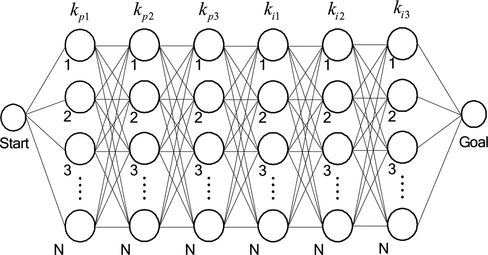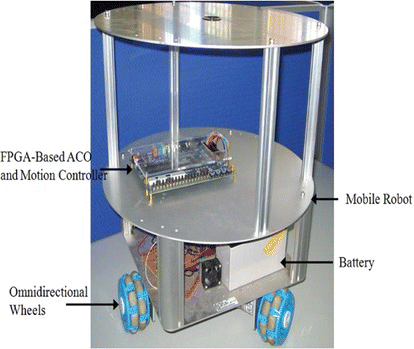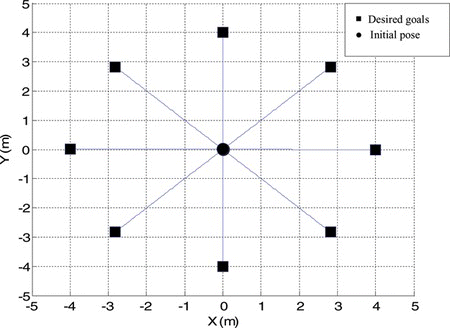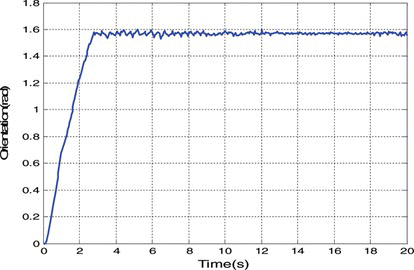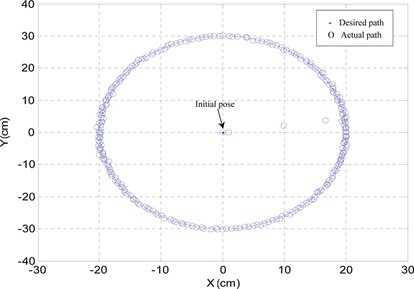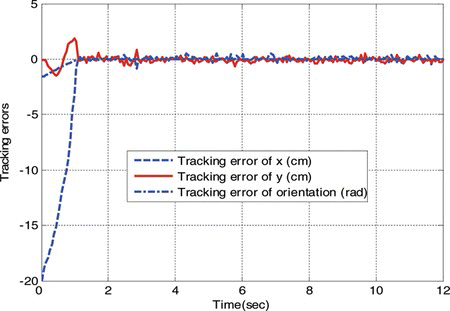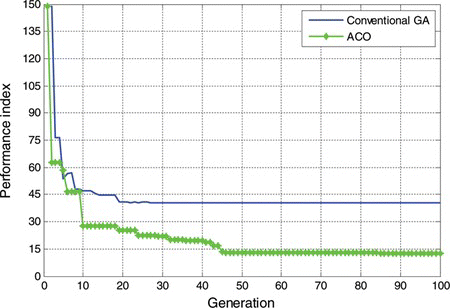Abstract
This article presents an intelligent system-on-a-programmable-chip-based (SoPC) ant colony optimization (ACO) motion controller for embedded omnidirectional mobile robots with three independent driving wheels equally spaced at 120 degrees from one another. Both ACO parameter autotuner and kinematic motion controller are integrated in one field-programmable gate array (FPGA) chip to efficiently construct an experimental mobile robot. The optimal parameters of the motion controller are obtained by minimizing the performance index using the proposed SoPC-based ACO computing method. These optimal parameters are then employed in the ACO-based embedded kinematic controller in order to obtain better performance for omnidirectional mobile robots to achieve trajectory tracking and stabilization. Experimental results are conducted to show the effectiveness and merit of the proposed intelligent ACO-based embedded controller for omnidirectional mobile robots. These results indicate that the proposed ACO-based embedded optimal controller outperforms the nonoptimal controllers and the conventional genetic algorithm (GA) optimal controllers.
INTRODUCTION
Recently, omnidirectional mobile robots have attracted much attention in both academia and industry in the field of robotics. This type of omnidirectional mobile mechanism has the superior agility to move toward any position and to attain any desired orientation in comparison with the car-like robots (Jiang and Nijmeijer Citation1999; Lee et al. Citation2001; Li, Chang, and Chen Citation2003). Modeling and controller design of omnidirectional mobile robots have been investigated by several researchers. For instance, Pin and Killough (Citation1994) presented the concepts for a family of holonomic wheeled platforms. Watanabe et al. (Citation1998) proposed a feedback controller of an omnidirectional autonomous platform for a mobile robot. Huang and Tsai (Citation2009b) proposed an embedded robust adaptive controller for autonomous omnidirectional mobile platform. Huang, Tsai, and Lin (Citation2011) proposed an adaptive polar-space motion control method for an embedded omnidirectional mobile robot with parameter variations and uncertainties. However, the controller parameters in the studies are determined by a trial-and-error approach; these studies did not cope with the controller-parameter optimization problems.
To date, there are some computing methods to address the optimal problems for mobile robots. Tsai, Huang, and Chan (Citation2011) presented a parallel elite GA and its application to global path planning for autonomous robot navigation. Tang et al. (Citation2001) proposed an optimal fuzzy proportional-integral-derivative (PID) controller. The fuzzy immune self-tuning PID controller was developed by Kan, Li, and Liu (Citation2008). Jung et al. (Citation1999) applied the neural network to solve the path-planning problem of mobile robots. Tsai, Huang, and Lin (Citation2011) developed a parallel DNA (deoxyribonucleic acid) algorithm for optimal configurations of an omnidirectional mobile robot. Among these approaches, ACO has been regarded as an effective metaheuristic algorithm in finding optimal solutions for difficult combinatorial problems (Dorigo, Maniezzo, and Colorni 2004; Chin and Hong Citation2009; Niknam et al. Citation2011).
The ACO algorithm proposed by Dorigo, Maniezzo, and Colorni (2004) is a population-based metaheuristic approach to solve difficult optimization problems. To apply ACO, the optimization problem is transformed into the problem of finding the best path on a graph consisting of nodes and edges. The artificial ants search for good solutions by moving on the ACO graph. This solution construction process is stochastic and is biased by a pheromone update model. Each ant constructs a solution by making a sequence of local decisions that are guided by pheromone information and some heuristic information. After a number of ants have constructed solutions, the best ants then update the pheromone information along their path. This process is repeated iteratively until a stopping criterion is met. This computing method has many advantages, including combining distributed computation, positive feedback, and constructive greedy heuristic. However, there has been no attempt to use ACO computing to design an intelligent system-on-a-programmable-chip-based optimal kinematic motion controller for omnidirectional mobile robots.
System-on-a-programmable-chip (SoPC) has been emerging as a new paradigm for computing science and electronic engineering and has begun a major revolution in the design of integrated circuits. This technology efficiently integrates embedded soft-core processor intellectual properties (IPs) and application IPs into a single reprogrammable field-programmable gate array(FPGA) chip. With the advantages of low-cost, programmability, hardware/software co-design, and IP reusability, the SoPC technology has shown to be a powerful means with which to design high-performance controllers (Campo et al. Citation2008; Tan, Wang, and Lee Citation2004; Solano et al. Citation2007; Kung, Huang, and Tsai Citation2009; Chan, Moallem, and Wang Citation2007; Huang and Tsai Citation2009b). To the author's best understanding, the SoPC technology has not been applied to the design of any ACO-based motion controllers for omnidirectional mobile robots.
The objectives of this study are to apply the ACO computing to the construction of an optimal kinematic motion controller in order to achieve stabilization and trajectory tracking for the autonomous omnidirectional mobile robots, and then to implement such an optimal controller in real time by employing the SoPC technology. Overall, the contributions of the article are threefold.
| 1. | The optimal ACO-based kinematic control law is presented for stabilization and trajectory tracking of the autonomous omnidirectional mobile robot. The proposed controller will be proven with the property of asymptotical stability via the Lyapunov stability theory. | ||||
| 2. | Both ACO-based kinematic controller and parameter tuner are implemented in one FPGA chip by using SoPC technology. This approach is very useful for constructing an experimental mobile robot. | ||||
| 3. | The SoPC-based ACO optimal controller incorporated with an embedded processor and an embedded operating system is employed to construct an experimental mobile robot. This SoPC-embedded ACO controller, combining the hardware/software co-design and IP reuse concept, has the advantages of efficient implementation, excellent flexibility, and better performance in comparison with the nonoptimal controllers (Watanabe et al. Citation1998; Huang and Tsai Citation2009b) and the conventional GA optimal controllers (Kuo and Li Citation1999) for omnidirectional mobile robots. | ||||
The rest of this article is organized as follows. In “Kinematic Motion Control,” the kinematic control law is proposed to achieve stabilization and trajectory tracking for the omnidirectional mobile robots. “ACO Computing for Kinematic Motion Control” elaborates on the ACO computing and its application to the parameter autotuning for the optimal motion controller. The SoPC implementation of the proposed ACO-based optimal controller is presented in “SOPC Implementation.” Several experiments to show the effectiveness and merit of the proposed methods are then presented in “Experimental Results and Discussion.” The final section concludes this article.
KINEMATIC MOTION CONTROL
This section is devoted to briefly describing the kinematic model of an omnidirectional mobile robot with three independent driving wheels equally spaced at 120 degrees from one another. With the kinematic model, a kinematic motion controller is proposed to achieve stabilization and trajectory tracking of the omnidirectional mobile robot.
Kinematic Model
Figure depicts the symmetric structure and geometry that is used to find the kinematic model of the mobile robot, where θ denotes the vehicle orientation. Due to structural symmetry, the vehicle has the property that the center of geometry coincides with the center of mass. The parameter L is the distance from each wheel to the center of mass, and denote the translational velocities of each wheel. The kinematic model of the three-wheeled omnidirectional mobile robot is summarized by
FIGURE 1 Geometry of the three-wheeled omnidirectional mobile robot. (Color figure available online.)
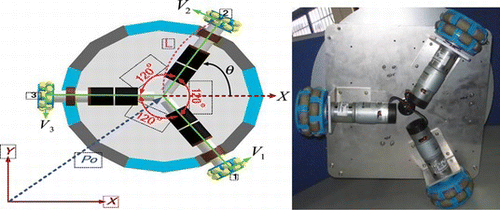
One can rewrite Equation (Equation1) in a vector-matrix form:
R denotes the radius of the driving wheels; L represents the distance from the wheel's center to the geometric center of the platform; V i and ω i , i = 1, 2, 3, respectively, denote the linear and angular velocities of each wheel. Note that the matrix P(θ)is always nonsingular for any θ, and
Kinematic Motion Control
With the kinematic model in Equation (Equation2), this subsection is devoted to designing a kinematic controller to achieve point-to-point stabilization and trajectory tracking for the omnidirectional mobile robot in Figure .
Point-to-Point Stabilization
The control goal is to find the controlled velocity vector to steer the mobile robot from any starting pose
to any desired pose
Note that the current pose of the mobile robot is
To design the stabilizer, one defines the pose error, which is the difference between the present pose and the desired destination pose, that is,
In order to asymptotically stabilize the system, the following control law is proposed.
Taking Equation (Equation6) into Equation (Equation5), the closed-loop error system is given by
For the asymptotical stability of the closed-loop error system, a radially unbounded Lyapunov function candidate is chosen as follows:
Taking the time derivative of Vobtains
Because is negative definite, the Lyapunov direct method implies that
. Therefore, the error system is asymptotically stable.
Trajectory Tracking
This subsection considers the time-varying trajectory-tracking problem. Given the time-varying path one defines the following tracking-error vector:
Thus, one obtains
Similarly, the control aim is to find a set of control velocity vectors that make the closed-loop system asymptotically stable. In doing so, one proposes a control law such that
Similar to point-to-point stabilization, the Lyapunov function candidate can be chosen as Equation (Equation7), and from Equation (Equation8) one can easily prove that the closed-loop error system for trajectory tracking control is asymptotically stable.
Remark 1
The kinematic control law in Equation (Equation10) will be reduced to the point-to-point stabilization law in Equation (Equation6) if the reference trajectory is independent of time, in other words, a point. This fact indicates that the control in Equation (Equation10) can be thought of as a unified control law to achieve both point-to-point stabilization and trajectory tracking for the kinematic model in Equation (Equation3).
Remark 2
Note that the gain matrices in the proposed control law in Equation (Equation10), K P = diag{k p1, k p2, k p3} and K I = diag{k i1, k i2, k i3}, are symmetric and positive definite to guarantee system stability. These parameters will influence the performance of the controller. However, these parameters were usually determined by the trial-and-error tuning procedure (Watanabe et al. Citation1998; Huang and Tsai Citation2009a,b).
ACO COMPUTING FOR KINEMATIC MOTION CONTROL
Although the kinematic motion controller for three-wheeled omnidirectional mobile robots was synthesized in Equation (Equation10), the two control matrices K P and K I were not optimally chosen to obtain optimal performance and guarantee system stability. The ACO computing will be employed to optimize the motion controller, thereby obtaining better performance in comparison with the nonoptimal controllers. This approach avoids the disadvantage of complex computation time in conventional GA-like algorithms (Kuo and Li Citation1999).
ACO Computing
ACO computing is a general-purpose optimization technique based on a graph consisting of nodes and edges for solving various combinatorial problems. The optimization solutions to the problems can be expressed in terms of feasible paths on the graph. Among these feasible paths, the ACO computing aims to find the one with a minimum performance index or cost.
In ACO computing, a colony of artificial ants is created to find solutions. At each generation, each ant completes a tour by choosing the nodes according to the transition rule. In order to prevent premature convergence, after completion of a path by each ant, the pheromone intensities on links are evaporated with a pheromone update rule. Each edge, (i, j) of the graph is associated with a total pheromone concentration, τ
ij
. At each node, each ant executes a decision policy to determine the next link of the path. If ant k is currently located at node i, it selects the next node based on the transition probability
The pheromone update rule is given by
Application to Kinematic Motion Control
This subsection aims to employ the ACO computing in the previous section in order to design an optimal kinematic controller for omnidirectional mobile robots. The controller parameters, such as K P = diag{k p1, k p2, k p3} and K I = diag{k i1, k i2, k i3} in Equation (Equation10) are optimized via the ACO algorithm to achieve trajectory tracking and stabilization for omnidirectional mobile robots.
The design of ACO-based controller with K P and K I can be represented as a graph problem shown in Figure with the parameters k p1, k p2, k p3, k i1, k i2 and k i3. There are 6N + 2 nodes to construct an ACO graph of the ACO-based controller with integral square error (ISE) performance index.
In the ACO-based optimal controller design, each ant constructs a path and then deposits the pheromone. Using the transition rule in Equation (Equation12) and the pheromone update rule in Equation (Equation14), every ant completes its tour to find the best path. The ACO computing applied for finding the optimal parameters k p1, k p2, k p3, k i1, k i2, k i3 is summarized as follows.
Step 1. Initialization.
| |||||||||||||||||
Step 2. Define m (the number on ant), t max(the maximum number of iterations), τ0(the initial pheromone concentration of each node) and ρ(the decay parameter). | |||||||||||||||||
Step 3. Each ant travels in the ACO-graph based on the probability in Equation (Equation12). If all ants complete their tours, calculate the cost (path length) for each ant's tour. | |||||||||||||||||
Step 4. Update pheromone τ ij using Equation (Equation14) for every edge (i, j). | |||||||||||||||||
Step 5. Check the stop criterion. If the stop criterion is not matched, go to Step 3 and set t = t + 1, otherwise, output the optimal path and its corresponding parameters k p1, k p2, k p3, k i1, k i2, k i3, and stop the algorithm. | |||||||||||||||||
Remark 3
The proposed ACO-tuning method can be easily applied to the feedback controller (Watanabe et al. Citation1998), dynamic controller (Huang and Tsai Citation2009b) or polar-space controller (Huang and Tsai Citation2009a) for omnidirectional mobile robots by taking the benefit of an intelligent autotuning approach rather than a trial-and-error tuning procedure.
SOPC IMPLEMENTATION
This subsection is devoted to designing an embedded ACO-based kinematic controller of the omnidirectional mobile robot in order to achieve the control law in Equation (Equation10). Figure depicts the architecture of the Altera FPGA implementation for the proposed ACO-based mobile robot motion controller using SoPC technology. Both the kinematic control law in Equation (Equation10) and the ACO-tuning algorithm have been implemented into the 32-bit Nios II processor, whose numerical precision and computation speed are high enough to realize the control law and the ACO algorithm. The user IP cores (custom logic), including quadrature-encoder-pulse (QEP) and decoder for this robotics application have been developed by VHDL (VHSIC Hardware Description Language). The software ACO-based motion controller and hardware custom logic are connected to the system interconnect fabric via Avalon bus for achieving the intelligent optimal controller in one FPGA chip. The D/A converters are employed to convert the output commands into analog voltage signals for driving three DC brushless motors mounted on the three omnidirectional wheels of the mobile robot.
With the QEP signals, the real position and orientation of the mobile robot can be dead reckoned by the embedded soft-core CPU Nios II. The real-time operating system (RTOS) MicroC/OS-II was ported into the FPGA chip to handle the data communication with the PC via TCP/IP protocol. Moreover, the embedded soft-core Nios II processor works with the lwIP (lightweight IP) for the Ethernet connectivity, thereby significantly reducing resource usage.
SoPC Implementation of the ACO-Based Controller
The embedded ACO-based controller of the mobile robot is presented in Figure , in which the Nios II embedded processor is employed to execute the ACO-tuning algorithm and control law. Figure depicts the flow chart of the embedded ACO-based controller program, in which the main program and the interrupt service routine (ISR) for the controller were coded in C/C++ language. In the main program, the ACO algorithm is executed by the processor to off-line tune the parameters k p1, k p2, k p3, k i1, k i2 and k i3. Furthermore, this parameter sequence will be used in the ISR kinematic motion controller program.
FIGURE 4 Main program and ISR for the proposed ACO-based control scheme executed by Nios II processor. (Color figure available online.)
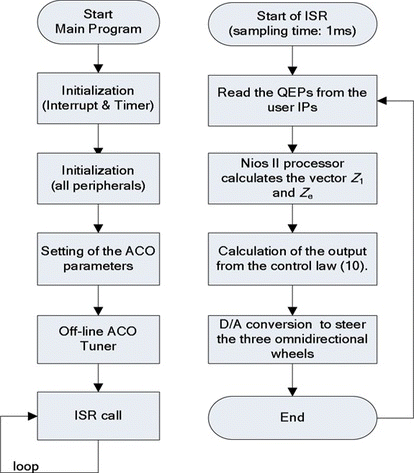
With the optimal parameters obtained from ACO tuner, the embedded processor calculates the current position and orientation of the mobile robot from QEP circuit via a dead-reckoning approach, and then obtains the values of Z 1 and Z e . Finally, the output of the control law is sent out to the D/A converters, thus steering the three omnidirectional wheels. Through the Nios II integrated development environment (IDE), the ACO-based controller program is cross-compiled and downloaded into the synchronous dynamic random access memory (SDRAM) via joint test action group (JTAG) interface.
SoPC Implementation of the ACO Parameter Tuner
As mentioned in the previous section, the off-line ACO parameter tuner plays a key role in the optimal kinematic controller. This subsection presents the SoPC implementation of the ACO parameter tuner, aiming to provide the optimized control sequence k p1, k p2, k p3, k i1, k i2 and k i3.The ACO computing for searching optimal parameters is described in “ACO Computing for Kinematic Motion Control,” in which the embedded processor is employed to perform not only the ACO-tuning process but also the control scheme. This processor works with the hardware IPs in one FPGA chip to achieve the stabilization and trajectory tracking tasks. This efficient ACO tuner searches for the optimal path in the ACO graph, resulting in an optimal sequence to the kinematic controller for the omnidirectional mobile robot.
Furthermore, the Nios II C-to-hardware acceleration (C2H) compiler is employed to create custom hardware accelerators directly from an ANSI C ACO tuner and control law source code; thus significantly improving execution performance of the software-based modules. The software program was developed for implementing the ACO-based optimal control algorithm, incorporated with the hardware module (user IP), lwIP, and embedded OS in one FPGA chip. With the hardware/software codesign and SoPC technology, the SoPC-based ACO kinematic controller has the advantage of software flexibility for complicated algorithms with low sampling frequency in motion control, and high sampling frequency required in hardware IP.
EXPERIMENTAL RESULTS AND DISCUSSION
The goals of the experiments are to examine the effectiveness and performance of the proposed SoPC-based ACO kinematic control law in Equation (Equation10) for the omnidirectional mobile robot. In order to illustrate the benefits of the proposed ACO-based optimal controller, these results are compared with the nonoptimal controller (Watanabe et al. Citation1998; Huang and Tsai Citation2009b) and the conventional GA-based controller (Kuo and Li Citation1999). The optimal sequence is obtained from the ACO computing with the following parameters: α = β = 1,
, Q = 2, m = 500.
System Architecture of the Experimental Omnidirectional Mobile Robot
The aim of the following experiments is to examine the effectiveness and performance of the proposed ACO-based embedded optimal controller by constructing an experimental mobile robot as shown in Figure . The driving omnidirectional wheels are driven by three DC24 V brushless servomotors with three mounted encoders of 300 pulses per revolution. The proposed ACO-tuning method and control law is implemented using C/C++ code and standard programming techniques in the Altera Nios II embedded processor. The FPGA chip integrated the embedded processor, RTOS, lwIP, and VHDL-based IP circuits for performing the SoPC-based ACO control law of the mobile robot. All the experiments were conducted with the system parameters: L = 19.4 cm and R = 5.08 cm.
Moreover, in the experiment, the three encoders were employed to measure the angular velocities of the three DC brushless motors in order to achieve the dead reckoning of the platform. The purpose of the dead reckoning of the platform is, given a correct initial pose, to continuously keep track of its correct poses with respect to the reference frame.
Point-to-Point Stabilization (Regulation)
The first experiment was conducted to investigate the regulation performance of the proposed SoPC-based ACO optimal control law. The initial pose of the omnidirectional mobile robot was assumed at the origin, in other words, , and the desired final eight goal poses were located on a circle with the radius of 400 cm and given by
Figure depicts all the experimental trajectories of the omnidirectional mobile robot from the origin to the eight goal positions, and Figure shows the heading behavior of the proposed ACO-based stabilization law for the robot moving toward the desired orientation π/2in the case α = π/4. Through experimental results, the mobile robot with the proposed ACO-based stabilization method has been shown capable of reaching the desired postures.
Elliptic Trajectory Tracking
The elliptic trajectory tracking experiment is aimed to explore how the proposed SoPC-based ACO controller in Equation (Equation10) steers the mobile robot to exactly track an elliptic trajectory described by
w
r
= 0.2 rad/sec with the desired orientation of π/2. The experiment assumed that the robot got started at
. Figures and , respectively, demonstrate the experimental results of elliptic trajectory tracking of the robot and the tracking errors for the elliptical trajectory. Furthermore, Figure presents the performance indexes of the controllers using the ACO-tuning method and the conventional GA-tuning approach. As shown in Figure , the proposed ACO tuner searches for the optimal solution more quickly than conventional GA does (Kuo and Li Citation1999). These results indicate that the proposed SoPC-based ACO optimal controller in Equation (Equation10) in the FPGA chip is capable of successfully steering the omnidirectional mobile robot to track the elliptic trajectory.
CONCLUSION
This article has presented an intelligent SoPC-based optimal kinematic controller using ACO computing for embedded omnidirectional mobile robots in order to achieve trajectory tracking and stabilization of an autonomous omnidirectional mobile robot with three independent driving wheels equally spaced at 120 degrees from one another. Based on the kinematic model, an optimal kinematic controller has been synthesized via ACO computing to achieve trajectory tracking and stabilization. Both ACO parameter tuner and kinematic motion controller are integrated in one FPGA chip to efficiently construct an experimental mobile robot. Through experimental results, the proposed ACO-based kinematic control method has been shown to achieve stabilization and trajectory tracking. These results indicate that the proposed ACO-based embedded optimal controller outperforms the nonoptimal controllers and the conventional GA optimal controllers.
REFERENCES
- Campo , I. , J. Echanobe , G. Bosque , and J. M. Tarela . 2008 . Efficient hardware/software implementation of an adaptive neuro-fuzzy system . IEEE Transactions on Fuzzy Systems 16 ( 3 ): 761 – 778 .
- Chan , Y. F. , M. Moallem , and W. Wang . 2007 . Design and implementation of modular FPGA-based PID controllers . IEEE Transactions on Industrial Electronics 54 ( 4 ): 1898 – 1906 .
- Chin , K. H. , and T. E. Hong . 2009. GACO-A hybrid ant colony optimization metaheuristic for the dynamic load-balanced clustering problem in ad hoc networks. Journal of Applied Artificial Intelligence 23 (7): 570–598.
- Dorigo , M. , V. Maniezzo , and A. Colorni . 1996 . The ant system: Optimization by a colony of cooperating agents . IEEE Transaction on Systems, Man, and Cybernetics-Part B 1 : 1 – 13 .
- Huang , H. C. , and C. C. Tsai . 2009a . Simultaneous tracking and stabilization of an omnidirectional mobile robot in polar coordinates: A unified control approach . Robotica 27 ( 3 ): 447 – 458 .
- Huang , H. C. , and C. C. Tsai . 2009b . FPGA implementation of an embedded robust adaptive controller for autonomous omnidirectional mobile platform . IEEE Transactions on Industrial Electronics 56 ( 5 ): 1604 – 1616 .
- Huang , H. C. , C. C. Tsai , and S. C. Lin . 2011 . Adaptive polar-space motion control for embedded omnidirectional mobile robot with parameter variations and uncertainties . Journal of Intelligent and Robotic Systems 62 ( 1 ): 81 – 102 .
- Jiang , Z. P. , and H. Nijmeijer . 1999 . A recursive technique for tracking control of nonholonomic systems in chained form . IEEE Transactions on Automatic Control 44 ( 2 ): 265 – 279 .
- Jung , I. K. , K. B. Hong , S. K. Hong , and S. C. Hong . 1999 . Path planning of mobile robot using neural network . Proceedings of the IEEE international symposium on industrial electronics 3 : 979 – 983 . Bled, Slovenia .
- Kan , J. , W. Li , and J. Liu . 2008 . Fuzzy immune self-tuning PID controller and its simulation . IEEE conference on industrial electronics and applications 625 – 628 . Singapore .
- Kung , Y. S. , C. C. Huang , and M. H. Tsai . 2009 . FPGA-realization of an adaptive fuzzy controller for PMLSM drive . IEEE Transactions on Industrial Electronics 56 ( 8 ): 2923 – 2932 .
- Kuo , Y. P. , and T. S. Li . 1999 . GA-based fuzzy PI/PD controller for automotive active suspension system . IEEE Transactions on Industrial Electronics 46 ( 6 ): 1051 – 1056 .
- Lee , T. C. , K. T. Song , C. H. Lee , and C. C. Teng . 2001 . Tracking control of unicycle-modeled mobile robots using a saturation feedback controller . IEEE Transactions on Control Systems Technology 9 ( 2 ): 305 – 318 .
- Li , T. H. , S. J. Chang , and Y. X. Chen . 2003 . Implementation of human-like driving skills by autonomous fuzzy behavior control on an FPGA-based car-like mobile robot . IEEE Transactions on Industrial Electronics 50 ( 5 ): 867 – 880 .
- Niknam , T. , M. Zare , J. Aghaei , and E. A. Farsani . 2011 . A new hybrid evolutionary optimization algorithm for distribution feeder reconfiguration . Journal of Applied Artificial Intelligence 25 ( 10 ): 951 – 971 .
- Pin , F. G. , and S. M. Killough . 1994 . A new family of omnidirectional and holonomic wheeled platforms for mobile robots . IEEE Transactions on Robotics and Automation 10 ( 4 ): 480 – 489 .
- Solano , S. S. , A. J. Cabrera , I. Baturone , F. J. Moreno-Velo , and M. Brox . 2007 . FPGA implementation of embedded fuzzy controllers for robotic applications . IEEE Transactions on Industrial Electronics 54 ( 4 ): 1937 – 1945 .
- Tan , K. C. , L. F. Wang , and T. H. Lee . 2004 . FPGA-based autonomous robot navigation via intrinsic evolution . Journal of Applied Artificial Intelligence 18 ( 2 ): 129 – 155 .
- Tang , K. S. , F. M. Kim , C. Guanrong , and S. Kwong . 2001 . An optimal fuzzy PID controller . IEEE Transactions on Industrial Electronics 48 ( 4 ): 757 – 765 .
- Tsai , C. C. , H. C. Huang , and C. K. Chan . 2011 . Parallel elite genetic algorithm and its application to global path planning for autonomous robot navigation . IEEE Transactions on Industrial Electronics 58 ( 10 ): 4813 – 4821 .
- Tsai , C. C. , H. C. Huang , and S. C. Lin . 2011 . FPGA-based parallel DNA algorithm for optimal configurations of an omnidirectional mobile service robot performing fire extinguishment . IEEE Transactions on Industrial Electronics 58 ( 3 ): 1016 – 1026 .
- Watanabe , K. , Y. Shiraishi , S. Tzafestas , J. Tang , and T. Fukuda . 1998 . Feedback control of an omnidirectional autonomous platform for mobile service robots . Journal of Intelligent and Robotic Systems 22 : 315 – 330 .
